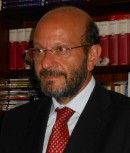
Professor Massimo Ceraolo
University of Pisa
Italy
E-mail: massimo.ceraolo@unipi.it
From Physical to Mathematical Circuits: Theoretical and Practical Issues

Professor Massimo Ceraolo
University of Pisa
Italy
E-mail: massimo.ceraolo@unipi.it
Abstract: Electrical engineers typically talk about “circuits”, without first defining what a circuit really is. If we mean circuits to be sets of elements containing insulating and conducting material, as well as magnetic material, nearly everything is a circuit.
If, instead, we mean circuits as “sets of elements in which some wires that connect components to each other are clearly distinguishable”, they constitute a set (the set of all possible circuits) that is a bit more limited, and maybe clear enough.
When talking about circuits, typically electrical engineers think of this latter definition. In addition, they typically assume that Kirchhoff’s equations are valid for all circuits.
This creates theoretical and practical issues that are normally underestimated. In particular:
• Kirchhoff’s laws are not valid in general. In the speech examples of “circuits” (according to the above definition) for which they are not valid are reported;
• the very concept of “potential” of points of the circuits is vague if not totally wrong.
The speech will discuss this inconsistence thoroughly and proposes a solution to the issues the fol-lowing approach:
• Systems in which electric and magnetic phenomena occur are simply called electromagnetic systems; for them Maxwell’s equations are valid, where Kirchhoff’s laws not only are not valid, but even loose meaning
• Systems in which electric magnetic phenomena occur and have a circuital shape, i.e. are com-posted by lumped components connected to each other by means of insulated wires, are called physical circuits. For them Maxwell’s equations are still valid; they are susceptible to be ab-stracted in such a way that, under given conditions, mathematical circuits can be inferred from them
• Mathematical circuits, or simply circuits, are abstracted structures, that constitute under given conditions, approximations of actual physical circuits, for which Kirchhoff’s equations are valid, or better, are postulated to be valid. As such, Kirchhoff’s equations are just the version of the continuity (charge conservation) equation and energy conservation for mathematical circuits. Instead of the Maxwell’s equations, for circuits Kirchhoff’s and constitutive equations are valid.
Once circuits (the short name of mathematical circuits) are defined, not all problems are solved.
In the speech, the author shows that to obtain circuits from physical circuits containing transmission lines, for which Kirchhoff’s laws are valid, is not always possible; however, a special version of them, that will be called metacircuit, will be introduced.
Again, it will be discussed that in circuits with ideal transformers do not allow Kirchhoff’s laws to be written in their more common form, and special treatment is needed.
Circuits are lumped component systems: i.e., systems composed by components that are connected to each other through interfaces. Therefore their behavior over time can be computer-simulated using object-oriented tools and languages. The final part of the speech will show that the modern si-mulation language Modelica has an approach that is one perfectly in line with the analysis of this speech, and even the graphical tricks used to evidence lumped components and connections are in total agreement with the Modelica approach.
This gives additional usefulness to the approach proposed in the speech, and in its companion paper.
Brief Biography of the Speaker: Born in 1960, he took his Ms Degree in Electrical Engineering from the University of Pisa, with honours, in 1985. For some years he has worked in an Italian private research centre. Since 1992 he has been working in Electric Power Systems first as a researcher, then as a professor.
He is full professor of Electric Power Systems since 2002, and teaches Electric and Hybrid Vehicles at the University of Pisa and on-board Electrical Systems at the Naval Academy of Livorno.
He is author or co-author of more than one hundred National and International scientific papers, mainly regarding power systems, electrochemical energy storage, and electric and hybrid vehicles.
He is the chairman of the School of Engineering of the University of Pisa, that coordinates teaching activities of around 250 researchers and professors.
He is the main author of the IEEE-Wiley book "Fundamentals of Electric Power Engineering – from Electromagnetics to Power Systems".